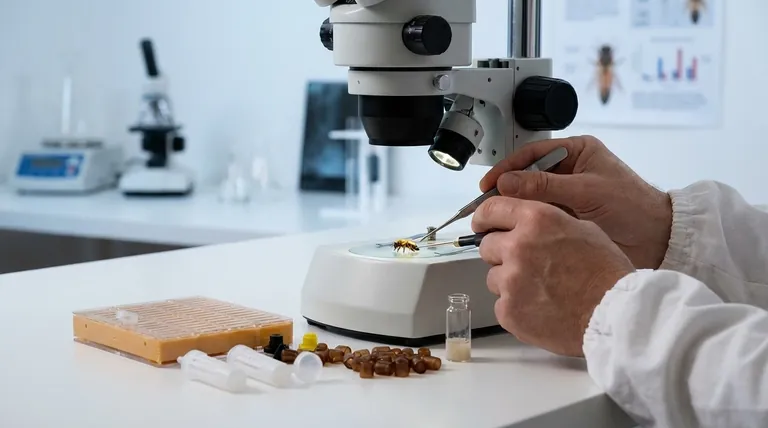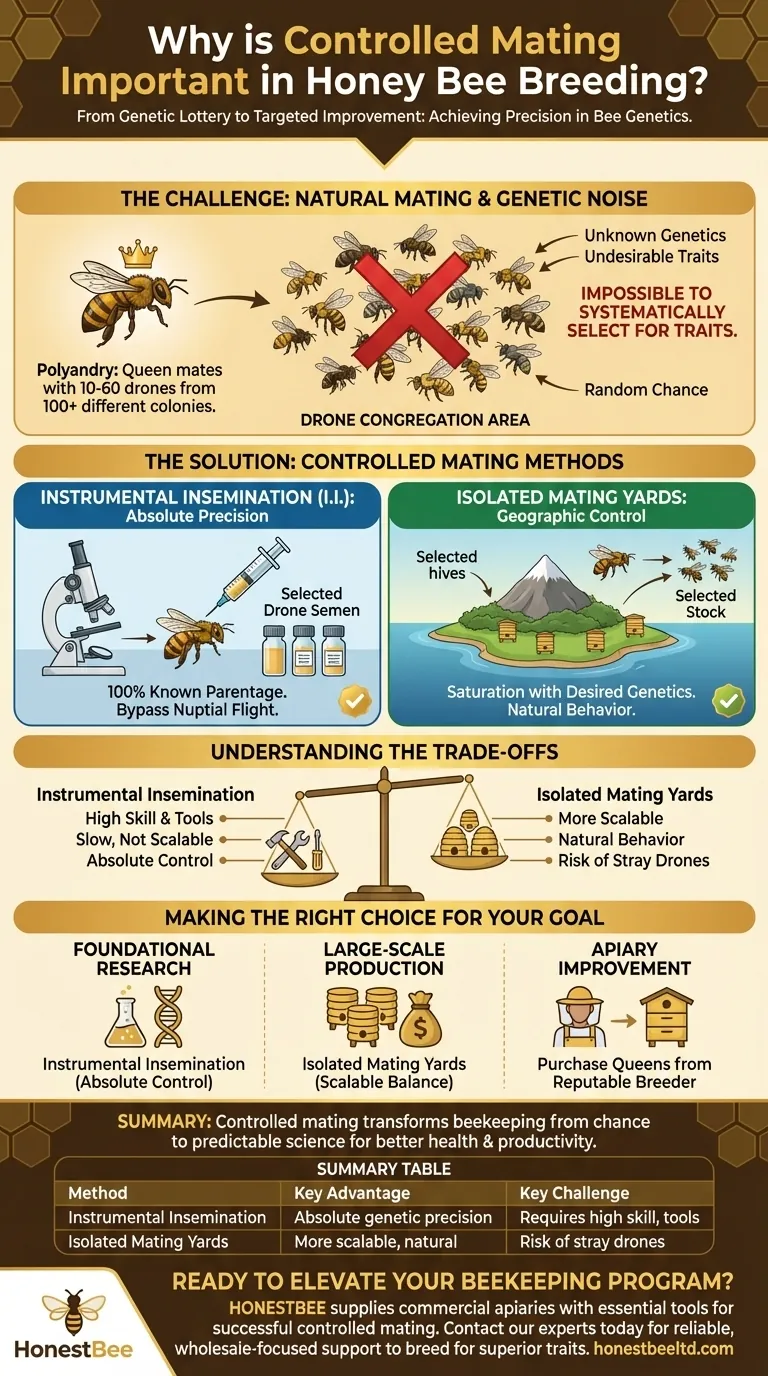In honey bee breeding, control is everything. Controlled mating is essential because a queen bee's natural mating process is inherently random and chaotic. She mates in mid-air with 10 to 60 drones from hundreds of different colonies, making it impossible for a breeder to systematically select for desirable traits like gentleness, disease resistance, or high honey production.
To consistently improve honey bee stock, breeders must move beyond the genetic lottery of natural open-mating. Controlled mating provides the necessary precision to pair a specific queen with drones from a specific paternal line, making targeted genetic improvement possible.

The Challenge of Natural Mating
The fundamental obstacle in any honey bee breeding program is the queen's nuptial flight. This single event dictates the genetic makeup of her entire colony for its lifespan.
A Queen's Nuptial Flight
A virgin queen embarks on one or more nuptial flights early in her life. She flies to a "drone congregation area" where thousands of drones from all surrounding apiaries have gathered.
The Problem of Polyandry
During these flights, the queen mates with numerous drones—a behavior known as polyandry. The number can range from 10 to 60 different males. She stores their sperm for the rest of her life to fertilize eggs.
The "Genetic Noise" of Open Mating
These drones come from a vast and genetically diverse population, representing potentially 200-300 different colonies in the area. This massive, uncontrolled influx of genetic material makes it impossible to select for or against specific traits with any reliability. The desired paternal genetics are simply drowned out by random chance.
Methods for Achieving Control
To overcome the randomness of open mating, breeders use two primary methods to dictate a queen's paternal lineage.
Instrumental Insemination: Absolute Precision
Instrumental insemination (I.I.) is a laboratory technique that provides complete genetic control. It involves collecting semen from specific, pre-selected drones and using specialized equipment to inseminate a virgin queen.
This method bypasses the nuptial flight entirely. It is the gold standard for breeding programs focused on developing and maintaining pure genetic lines, as the parentage is 100% known and recorded.
Isolated Mating Yards: Geographic Control
An alternative is to use an isolated mating yard. A breeder establishes a remote apiary in a location with no other honey bee colonies, such as an island, a desert, or a mountain valley.
The area is then saturated with drones from colonies that have the desired genetic traits. When the virgin queens from this yard take their nuptial flights, the vast majority of drones they encounter will be from the breeder's selected stock.
Understanding the Trade-offs
While both methods provide control, neither is a perfect solution. Each comes with significant operational considerations.
The Cost and Skill of Insemination
Instrumental insemination offers unparalleled precision, but it requires a high level of technical skill, a microscope, and other specialized tools. It is a slow, one-by-one process that is not easily scalable for large-scale queen production.
The Limitations of Isolation
Isolated mating yards allow for more natural mating behavior and are more scalable, but control is never absolute. A stray drone from miles away can still find its way into the congregation area, introducing unwanted genetics. Furthermore, finding a truly isolated location can be a major logistical and geographical challenge.
Making the Right Choice for Your Goal
The best approach depends entirely on the specific goals of the beekeeper or breeding program.
- If your primary focus is foundational research or developing a new, pure genetic line: Instrumental insemination is the only method that provides the absolute control required for this work.
- If your primary focus is producing a large number of improved queens for sale: Isolated mating yards offer a practical and scalable balance between genetic control and operational efficiency.
- If your primary focus is simply improving the stock in your own apiary: The most effective strategy is to purchase queens from a reputable breeder who already utilizes these controlled mating techniques.
Ultimately, controlled mating transforms beekeeping from a game of chance into a predictable science, enabling the consistent improvement of honey bee health and productivity.
Summary Table:
| Method | Key Advantage | Key Challenge |
|---|---|---|
| Instrumental Insemination | Absolute genetic precision | Requires high skill, specialized tools |
| Isolated Mating Yards | More scalable, natural behavior | Risk of stray drones, logistical challenge |
Ready to Elevate Your Beekeeping Program?
HONESTBEE supplies commercial apiaries and beekeeping equipment distributors with the essential tools for successful controlled mating programs. From equipment for instrumental insemination to supplies for establishing isolated mating yards, we provide the reliable, wholesale-focused support you need to achieve predictable genetic improvements. Contact our experts today via our [#ContactForm] to discuss how our solutions can help you breed for superior traits like gentleness, disease resistance, and high productivity.
Visual Guide

Related Products
- Nicot Queen Rearing Kit for Beekeeping and Grafting in Nicot System
- No Grafting Queen Rearing Kit: System for Royal Jelly Production and Queen Rearing
- Double Head Beekeeping Grafting Tools for Beekeepers
- Plastic Chinese Queen Grafting Tool for Bee Queen Rearing
- Durable Galvanized Steel Spring Queen Bee Cage
People Also Ask
- What are the benefits of queen rearing for beekeepers? Gain Total Control Over Your Apiary's Genetics
- What are the different methods for raising queen bees? Master the Trade-Off Between Simplicity and Control
- What should be done once eggs are present in the comb box? A Guide to Maximizing Queen Rearing Success
- What happens if a larva is grafted too late? Avoid Scrub Queens and Failed Rearing
- What is essential for successful queen rearing in beekeeping? Master Genetics & Boost Your Apiary's Health



















